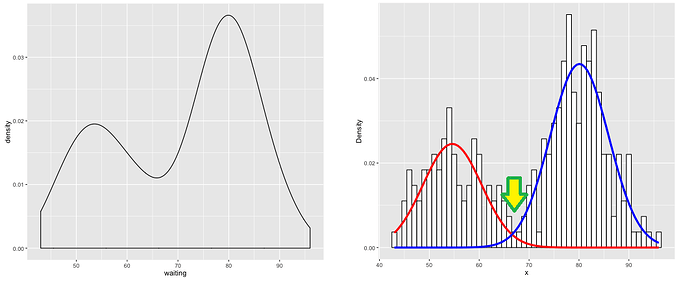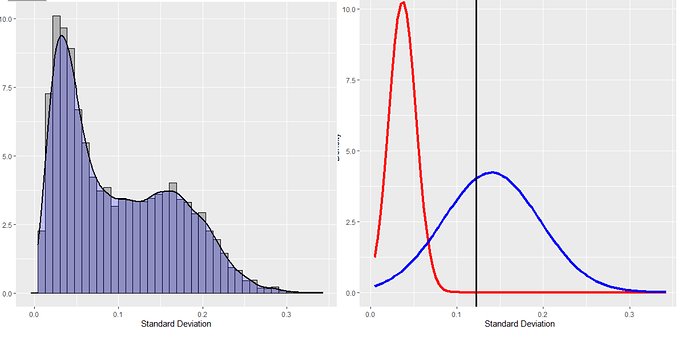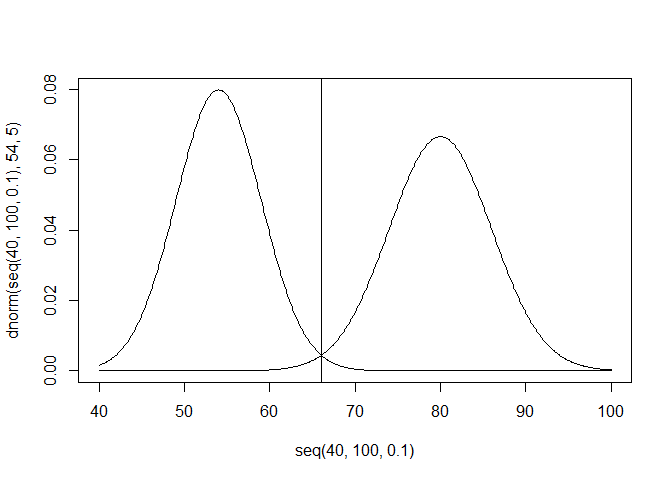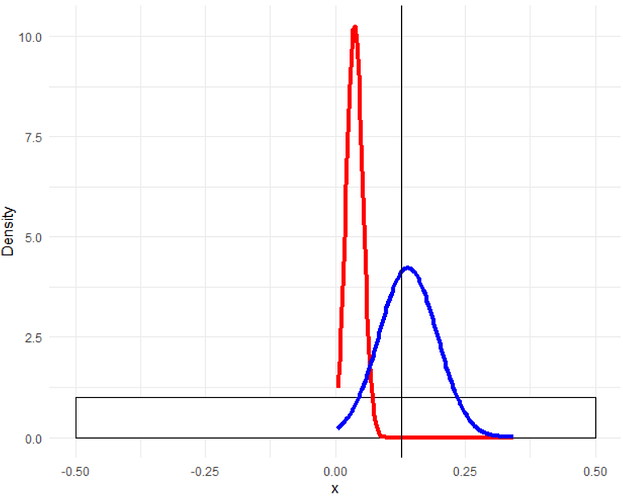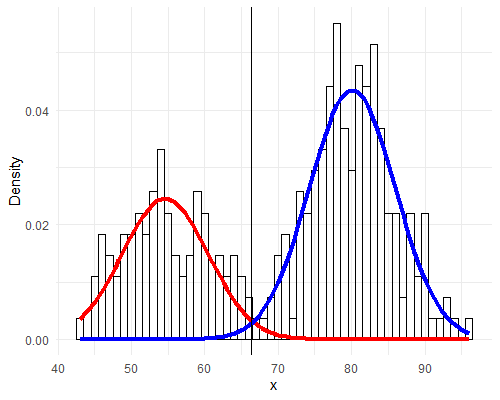Shouldn't be too hard to adapt snippet below, which is used to find, and plot, local maxima. (Says the man who's too lazy to do it himself.)
suppressPackageStartupMessages({
library(ggplot2)
})
df1 <- data.frame(
x = c(
16,
16.564238781462,
17.1483754005807,
17.7531115530855,
18.3791736799526,
19.0273138400435,
19.6983106135187,
20.3929700371082,
21.1121265723663,
21.8566441080703,
22.6274169979695,
23.42537113513,
24.2514650641664,
25.106691132696,
25.9920766833995,
26.9086852881189,
27.857618025476,
28.8400148035466,
29.8570557291778,
30.9099625255951,
32,
33.1284775629241,
34.2967508011614,
35.506223106171,
36.7583473599051,
38.0546276800871,
39.3966212270373,
40.7859400742164,
42.2242531447326,
43.7132882161407,
45.254833995939,
46.85074227026,
48.5029301283327,
50.213382265392,
51.9841533667991,
53.8173705762377,
55.7152360509519,
57.6800296070931,
59.7141114583557,
61.8199250511901,
64,
66.2569551258482,
68.5935016023228,
71.0124462123421,
73.5166947198102,
76.1092553601741,
78.7932424540747,
81.5718801484328,
84.4485062894653,
87.4265764322813,
90.5096679918781,
93.70148454052,
97.0058602566655,
100.426764530784,
103.968306733598,
107.634741152475,
111.430472101904,
115.360059214186,
119.428222916711,
123.63985010238,
128,
132.513910251696,
137.187003204646,
142.024892424684,
147.03338943962,
152.218510720348,
157.586484908149,
163.143760296866,
168.897012578931,
174.853152864563,
181.019335983756,
187.40296908104,
194.011720513331,
200.853529061568,
207.936613467196,
215.269482304951,
222.860944203808,
230.720118428373,
238.856445833423,
247.279700204761,
256,
265.027820503393,
274.374006409291,
284.049784849368,
294.066778879241,
304.437021440697,
315.172969816299,
326.287520593731,
337.794025157861,
349.706305729125,
362.038671967512,
374.80593816208,
388.023441026662,
401.707058123136,
415.873226934393,
430.538964609902,
445.721888407616,
461.440236856745,
477.712891666846,
494.559400409521,
512,
530.055641006786,
548.748012818582,
568.099569698737,
588.133557758482,
608.874042881393,
630.345939632597,
652.575041187462,
675.588050315722,
699.412611458251
),
y = c(
0.000509477897425229,
0.000527386888743664,
0.000546053806503485,
0.000563536347150758,
0.000578694693557497,
0.000592184934692638,
0.000606880432664763,
0.00062740434643328,
0.000658951780340787,
0.000706022263900694,
0.000771695560505854,
0.000857665701641295,
0.000964821690647073,
0.00109410977624778,
0.00124762020201182,
0.00142985018853286,
0.00164871137836403,
0.00191549532233234,
0.00224333357803463,
0.00264484132738257,
0.00313097018738546,
0.00371357432026318,
0.004413116507083,
0.00527051763162741,
0.00635951029446201,
0.00779442118237125,
0.00972891845147851,
0.0123436051467146,
0.0158230846458223,
0.0203248591277636,
0.0259430773877464,
0.0326716119103998,
0.0403751637620158,
0.0487822072022065,
0.0575125639221519,
0.0661386623990792,
0.0742571414246156,
0.0815347852470562,
0.0877087303679976,
0.0925592583028204,
0.0958964121231122,
0.0975778467891361,
0.0975299735518198,
0.0957428778093582,
0.0922662141274413,
0.0872674196185096,
0.0811466237435986,
0.0745892159235216,
0.0684282888234455,
0.0633408656175527,
0.0595754289702118,
0.0569149855310437,
0.0549012076098515,
0.0531548543217289,
0.0515892280330073,
0.0504152091574836,
0.0499599635705786,
0.0504031217012216,
0.0515799825745852,
0.0529930988557304,
0.0540733795338386,
0.0545753160201401,
0.0548889928851148,
0.0560788146361983,
0.0595912907883012,
0.0667366977351586,
0.0781688004268401,
0.0935992678733074,
0.111863211025667,
0.131261468491735,
0.14996894361554,
0.166304089020949,
0.178792397549176,
0.186142519356196,
0.187370254991816,
0.182238791895045,
0.171908697734763,
0.159376822267072,
0.149232179773896,
0.14661852192979,
0.15582462684655,
0.17916710287631,
0.216598366309568,
0.26603216591513,
0.324083541154487,
0.386820517224485,
0.450113246364986,
0.509323652377758,
0.558573294272359,
0.590463672842883,
0.597264437175175,
0.573745920439653,
0.520380960986617,
0.444758790690755,
0.359750166225963,
0.278987238175495,
0.21206887381186,
0.162091637731931,
0.12651426193784,
0.100279095709724,
0.0790468365289463,
0.0608671439409344,
0.0459482418843581,
0.0353311402777704,
0.0295872989249962,
0.0282323900120659,
0.0298985530326881,
0.032896184060171,
0.0357555698838089,
0.0375239368848331
)
)
p <- ggplot(df1, aes(x, y)) +
geom_point() +
theme_minimal()
p
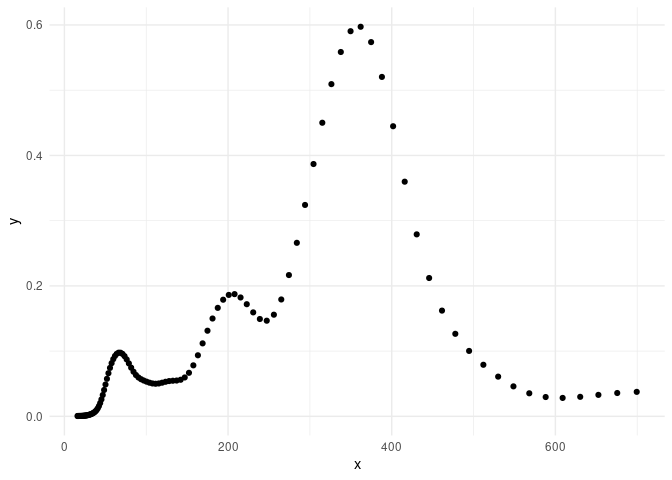
which(diff(sign(diff(df1$y))) == -2) + 1 -> positions
# positions
#[[[[ [1] 42 75 91
indices <- df1[positions, 1]
p +
geom_vline(xintercept = indices[1]) +
geom_vline(xintercept = indices[2]) +
geom_vline(xintercept = indices[3])
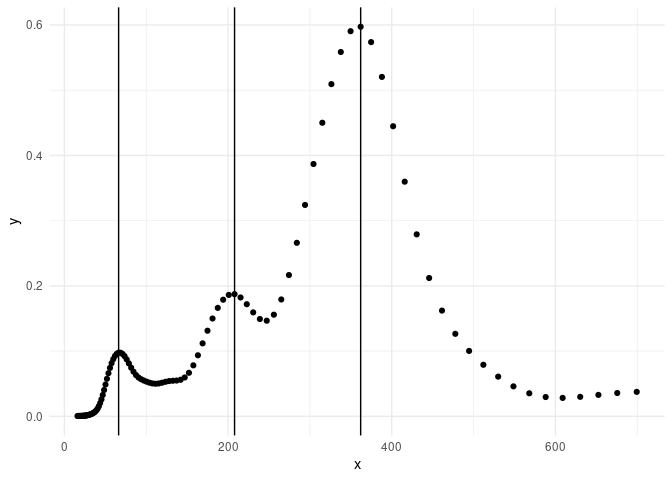
Created on 2021-01-05 by the reprex package (v0.3.0.9001)
